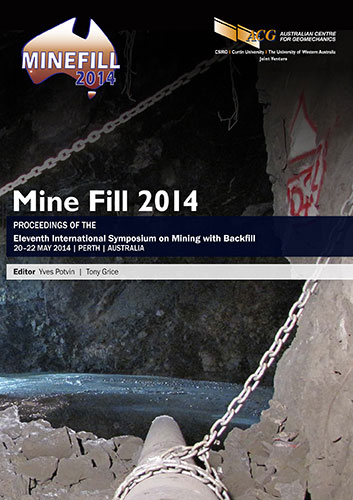Backfill barricade design – determination of backfill behaviour and site conditions in structural barricade design

|
Authors: Kay, G Paper is not available for download Contact Us |
DOI https://doi.org/10.36487/ACG_rep/1404_10_Kay
Cite As:
Kay, G 2014, 'Backfill barricade design – determination of backfill behaviour and site conditions in structural barricade design', in Y Potvin & T Grice (eds), Mine Fill 2014: Proceedings of the Eleventh International Symposium on Mining with Backfill, Australian Centre for Geomechanics, Perth, pp. 151-158, https://doi.org/10.36487/ACG_rep/1404_10_Kay
Abstract:
Establishing safe and efficient solutions to mine fill development has led to many innovations in underground mining. However, while advancements in backfill techniques and materials have progressed significantly in recent years, the variability of site conditions, combined with the potential behaviour and loading of fill materials, continues to pose a challenge for structural design principles of barricades. As the industry strives to formalise standards for containment devices, the introduction of new engineering approaches not only contributes to mine fill innovation, but also provides the industry with the assurance of knowing that their containment devices increase the safety factor in underground mine environments. In designing containment barricades, the material properties, fill rate and cure times, combined with an analysis of the surrounding strata conditions, play a significant role in determining the structural design and Factor of Safety of the device. While these properties may differ from other site conditions that are prevalent in underground mines, the ability to apply research and learnings is extremely advantageous to mine fill development. In addition to reviewing the various factors influencing mine fill containment, this paper draws a comparison to the design of other structural devices, including underground dam walls and ventilation seals, where responses to load and pressure determine the design of the structural device. Using a range of studies conducted at coal mines around Australia, it will outline the fill pressures and stress loading on the behaviour of structural components and will assess current testing and monitoring processes. With data obtained from live underground testing of various structural devices, load dynamics and responses to different stresses are analysed to establish a model for structural device specification.
References:
Foreman, J 1998, ‘Engineered structures for sealing underground mines’, Proceedings of the Nineteenth Annual West Virginia Surface Mine Drainage Task Force Symposium, viewed 25 March 2014,
/98/98FOR/98FOR.HTM.
Kay, G, & Salu, MS 2009, ‘Performance testing and certification of ventilation control devices’, Proceedings of the Queensland Mines Inspectorate Sealing Parts of a Coal Mine Seminar 2009, Queensland Mines Inspectorate.
Kay, G, Salu, MS 2011, ‘Advances in In-Situ Testing of Ventilation Control Devices for Underground Mines’, Proceedings of the University of New South Wales Mine Ventilation Conference 2011, viewed 25 March 2014, wp-content/uploads/UNSW-Mine-Ventilation-Conference-2011-Presentation-final-copy.pdf.
Kay, G & Salu, MS 2012, ‘Evaluation of Structural component design in life-of-mine planning’, Proceedings of the 2013 Coal Operators Conference, University of Wollongong, Wollongong, viewed 25 March 2014, viewcontent.cgi?article=2138&context=coal.
Oberholzer, JW 2002, Develop In-Situ Test Methods for Ventilation Structures – Phase 1, ACARP Final Report C10014 May 2002, Australian Coal Association Research Program, Brisbane.
Pearson, D, Gillies, ADS, Day, R & Dux P 2000a, Evaluation of a Full Scale Pressure Test for Ventilation Control Devices, ACARP Final Report C8006 December 2000, Australian Coal Association Research Program, Brisbane.
Pearson, D, Gillies, ADS, Green, A, Day R & Dux, P 2000b, ‘New approaches to the design and evaluation of mine stoppings and seals’, Proceedings of the Queensland Mining Industry Health and Safety Conference, Queensland Government Department of Mines and Energy, Brisbane, viewed 25 March 2014, .
Salu, MS 2005, ‘Predicting the performance of underground mine seals’, Technical Excellence Committee presentation for Parsons Brinckerhoff, Brisbane, Queensland.
Thompson, BD, Grabinsky, MW, Bawden, WF & Counter, DB 2009, ‘In-situ measurements of cement paste backill in long-hole’, in M Diederichs & G Grasselli (eds), Proceedings of the 3rd Canada-US Rock Mechanics Symposium & 20th Canadian Rock Mechanics Symposium, University of Toronto Press, Toronto, on CD-ROM.
© Copyright 2025, Australian Centre for Geomechanics (ACG), The University of Western Australia. All rights reserved.
View copyright/legal information
Please direct any queries or error reports to repository-acg@uwa.edu.au
View copyright/legal information
Please direct any queries or error reports to repository-acg@uwa.edu.au